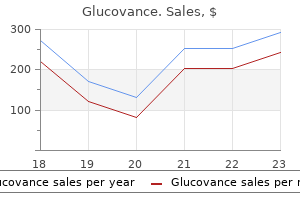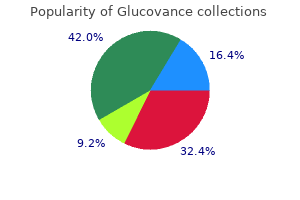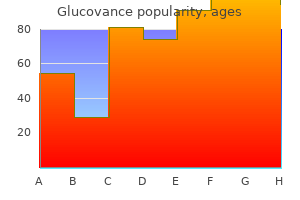

Glucovance dosages: 500/5 mg, 400/2.5 mg
Glucovance packs: 30 pills, 60 pills, 90 pills, 120 pills, 180 pills, 240 pills, 360 pills

Elemental barium doses in these intermediate and chronic drinking water studies ranged from 15 to 450 mg/kg/day xerogenic medications glucovance 500/5 mg cheap with visa. The predominant musculoskeletal effect observed in cases of barium toxicity in humans is progressive muscle weakness, often leading to partial or total paralysis (Das and Singh 1970; Diengott et al. The likely cause of the muscle weakness was the barium-induced hypokalemia rather than a direct effect on muscles. Very limited animal data are available regarding the musculoskeletal effects of barium following oral exposure. No gross and microscopic lesions were observed in skeletal system of several intermediate and chronic experiments in which rats were exposed to an unspecified barium compound or barium chloride in drinking water at doses as high as 180 mg barium/kg/day for intermediate duration and as high as 60 mg barium/kg/day for chronic duration (McCauley et al. In one case study involving accidental acute ingestion of barium carbonate in an adult female, some degeneration of the liver was noted post-mortem (McNally 1925). Adverse hepatic effects in animals following oral barium exposure have been minor or have not been observed. Decreased liver/brain weight ratio and darkened liver were observed in rats administered a single gavage dose of 198 mg barium/kg as barium chloride; however, these changes were not associated with any microscopic hepatic lesions or alterations in serum enzymes. No histological or liver weight alterations were observed in rats dosed with 198 mg barium/kg/day as barium chloride for 1 or 10 days (Borzelleca et al. Intermediate and chronic studies involving oral exposure of rats or mice to barium in drinking water did not find significant alterations in liver weight or liver histopathology following exposure to doses as high as 180 mg barium/kg/day for rats and 450 mg barium/kg/day for mice (McCauley et al. Toxic effects on the kidneys have been observed in several adult cases of acute barium poisoning. Studies in animals suggest that the kidney is a critical target of barium toxicity. Increases in relative kidney weight (kidney to brain weight ratio) were also observed in female rats receiving gavage doses of 66, 96, or 138 mg barium/kg/day as barium chloride in water for 10 days, but not at 198 mg barium/kg/day (Borzelleca et al.
Syndromes

This rhythm is regulated in the intact brain by a number of influences that enter via the vagus and glossopharyngeal nerves symptoms 6 days before period glucovance 400/2.5 mg order overnight delivery. These control airway and respiratory reflexes, analogous to the cardiovascular system, by inputs to the ventrolateral medulla. These include outputs to the airways via the vagus nerve (red) and outputs from the ventral respiratory group (orange) to the spinal cord, controlling sympathetic airway responses (green) and respiratory motor (phrenic motor nucleus, blue) and accessory motor (hypoglossal and intercostal, blue) outputs. However, it is assisted in this process by the parabrachial nucleus (or pontine respiratory group, purple), which receives ascending respiratory afferents and integrates them with other brainstem reflexes. The prefrontal cortex (brown) provides behavioral regulation of breathing, producing a continual breathing rhythm even in the absence of metabolic need. This influences the hypothalamus (light green), which may vary respiratory pattern in coordination with behavior or emotion. Examination of the Comatose Patient 49 the carotid sinus branch of the glossopharyngeal nerve brings afferents that carry information about blood oxygen and carbon dioxide content, whereas the vagus nerve conveys pulmonary stretch afferents. These terminate in the commissural, ventrolateral, intermediate, and interstitial components of the nucleus of the solitary tract. These influences are relayed to reticular areas in the ventrolateral medulla that regulate the onset of inspiration and expiration. On the other hand, neurons located more ventrally in the intertrigeminal zone, between the principal sensory and motor trigeminal nuclei, produce apneas, which are necessary during swallowing and in response to noxious chemical irritation of the airway. Respiration can be altered by emotional response, and it increases in anticipation of metabolic demand during voluntary exercise, even if the muscle that is to be contracted has been paralyzed. The pathways that control vocalization in humans appear to originate in the frontal opercular cortex, which provides premotor and motor integration of orofacial motor actions. However, there is also a prefrontal contribution to the maintenance of respiratory rhythm, even in the absence of metabolic demand (the basis for posthyperventilation apnea, described below). By contrast, subjects with diffuse metabolic impairment of the forebrain, or bilateral structural damage to the frontal lobes, commonly demonstrate posthyperventilation apnea.
When focal neurologic findings are observed medicine jar paul mccartney discount glucovance 400/2.5mg amex, it becomes imperative to determine whether there is a destructive or compressive process that may become life threatening or irreversibly damage the brain within a matter of minutes. On the other hand, even when there is no focal or lateralizing finding to suggest a structural lesion, it is important to know which signs point to specific metabolic causes, such as hypoglycemia or sepsis, that must be sought urgently. Therefore, the physician should become familiar with the few focal neurologic findings that are seen in patients with diffuse metabolic causes of coma, and understand their implications for the diagnosis of the metabolic problem. Respiratory Responses the range of normal respiratory responses includes the Cheyne-Stokes pattern of breathing, which is seen in many cognitively normal people with cardiac or respiratory disorders, particularly during sleep. Patients with severe sleep apnea may stop breathing for 10 seconds or so every minute or two. Their color may become dusky during the oxygen desaturation that accompanies each period of apnea. This must be distinguished from sepsis, hepatic encephalopathy, or cardiac dysfunction, conditions that often cause a primary respiratory alkalosis, with compensatory metabolic acidosis. Signs of major motor seizure, such as tongue biting or incontinence, or a transient metabolic acidosis are helpful in alerting the examiner to the possibility of a recent seizure. In addition, because the seizure usually results in the release of adrenalin, the pupils typically are large after a seizure. Very deep coma due to sedative intoxication may suppress all brainstem responses, including pupillary light reactions, and simulate brain death (see Chapter 6). For this reason, it is critical to do urinary and blood toxic and drug screening on any patient who is so deeply comatose as to lack pupillary responses. Pupillary Responses A key problem with interpreting pupillary responses is that either metabolic coma or diencephalic level dysfunction may cause bilaterally small and symmetric, reactive pupils. Thus, a patient with small pupils and little in the way of focal neurologic impairment may still have impairment that can be attributed to either a diencephalic lesion or to symmetric forebrain compression. As a result, it is generally necessary to do an imaging study (see below) within the first few hours in most comatose patients, even if the cause is believed to be metabolic.

An additional two groups of animals exposed to 0 or 125 mg/kg of body weight per day were kept for a 2-week recovery period medicine cabinet home depot 500/5mg glucovance buy visa. Decreased movement, pale skin, gait abnormalities and decreases in body weights or body weight gains were seen at the high dose. Increases of total cholesterol and albumin and decreases in blood urea nitrogen were seen at the middle and high doses, and increases of albumin/globulin ratio in both sexes and alanine aminotransferase, alkaline phosphatase and total protein were observed in females in the high-dose group. Increases in weights of the liver, spleen and kidney and decreases in the weights of the testis and thymus were seen at the high dose. Increased liver weights were also seen in low-dose males, whereas increased spleen weights were seen in both sexes at the middle dose. Histopathology revealed spongiotic changes and brown pigmentation in the perivascular region of the cerebellum, degeneration of seminiferous tubular epithelium and atrophy of seminiferous tubules at 125 mg/kg of body weight per day. The above findings disappeared or tended to decrease during or at the end of the recovery period. All rats and mice at the high dose of 600 mg/kg of body weight per day and all rats at 300 mg/kg of body weight per day died or were sacrificed in a moribund condition prior to the end of treatment. Histologically, mice and rats showed changes in the brain, liver, lung, kidney and spleen. Clinical signs included ataxia, lethargy, dyspnoea, convulsions, irritability and rapid headbobbing movements. Liver weight in treated mice was increased compared with controls; the increase was statistically significant at the two highest doses in males and at all doses in females. Fatty change was reported in the X-zone (basophilic cells that surround the medulla around 10 days of age, then gradually disappear as mice mature) of the adrenal glands of 8 of 10 high-dose female mice. One high-dose male had acute necrosis in the area of the vestibular nucleus in the brain. Nitrobenzene was administered to Fischer-344 rats (10 per sex per group) by gavage (in corn oil) at doses of 0, 9. Seven high-dose male rats died, and 2 of 10 were sacrificed moribund during weeks 10, 11 and 13. Clinical signs included ataxia, left head tilt, lethargy, trembling, circling and dyspnoea, as well as cyanosis of the extremities in the two highest dose groups in both sexes.

Neoplasms of the neuroendocrine system and neoplasms of the gastroenteropancreatic endocrine system medicine definition generic glucovance 400/2.5mg amex. Distinguishing signs and symptoms of each syndrome will further aid the diagnosis. Paraendocrine tumors secrete a peptide or amine that is foreign to the organ or cell of origin. The Clinical Presentations, Syndromes, Tumor Types, Sites, and Hormones Table 1-1. The incidence of carcinoid has risen in the last 10 years, particularly those found in the stomach and ileum. These tumors are nicknamed "zebras" because of their rarity, but despite their infrequent occurrence, physicians are fascinated by their complexity and the unusual nature of their presentations. The prevalence of carcinoids is about 50,000 cases in any 1 year in the United States. Nonetheless, they account for 13% to 34% of all tumors of the small bowel and 17% to 46% of all malignant tumors of the small bowel. Carcinoids may, however, occur in the bronchus, pancreas, rectum, ovary, lung, and elsewhere. The tumors grow slowly and often are clinically silent for many years before metastasizing. They frequently metastasize to the regional lymph nodes, liver, and, less commonly, to bone. The incidence of metastases is less than 15% with a carcinoid tumor smaller than 1 cm but rises to 95% with tumors larger than 2 cm. In individual cases, size alone may not be the only determinant of lymphatic or distant spread. Lymphatic or vascular invasion, or spread into the fat surrounding the primary tumor, may be an indicator of a more aggressive tumor (Table 1-2). Tumor Location and Frequency of Metastases (n=5468) Gut Location Stomach Foregut Duodenum Lung Jejunum Midgut Ileum Appendix Colon Hindgut Percentage of Tumors 38 21 32. Carcinoid and pancreatic endocrine tumors: recent advances in molecular pathogenesis, localization, and treatment.
Jaroll, 27 years: Bullets should be marked by an expert who will not alter the patterns used for identification. Results of a third study indicated that relative to communities with little or no barium in drinking water, communities with elevated concentrations of barium in their drinking water had significantly higher mortality rates for all causes, heart disease, arteriosclerosis, and all cardiovascular disease (Brenniman and Levy 1985; Brenniman et al. Standards for Certification & Accreditation 2018 Sa Able to control horse nl y Gaits Date Gaits Date Gaits Volunteer/Staff Information Form and Health History General Information Name: Date: Address: Employer/School: Address: Parent/Legal Guardian/Caregiver Name/Address/Phone Number: How did you learn about the program Pediatric craniopharyngiomas: long term results of combined treatment with surgery and radiation.
Ismael, 61 years: If tissue oxygenation is restored immediately, consciousness returns in seconds or minutes without sequelae. Morphologic changes the morphologic changes refer to the structural alterations in cells or tissues that occur following the pathogenetic mechanisms. The similarity of the p-values makes it impossible to select one metric over another on the basis of agreement with the dose-response of the incidence data. The authors observed disturbed attention and impaired processing speed in craniopharyngioma patients; not surprisingly, the deficits were most pronounced in patients with hypothalamic involvement of childhood craniopharyngioma (204).
Ramirez, 54 years: Antacid medications, anti-histamine medications, aspirin, indomethacin, anti-inflammatory medications, and medications affecting motility or pancreatic function should be discontinued, if possible, for at least 48 hours prior to collection. Importantly, perception of mental health and the presence of physical pain correlated with the frequency of suicidal thoughts (r � �0. Compliance Demonstration: Visitor observation and verification of a working auditory signal. Bone also houses the marrow which contains hematopoietic precursors of myelogenic tumors.